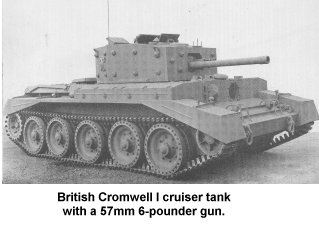Armor in World War II
The French
At the onset of World War II, the French enjoyed a numerical
superiority in armored vehicles of better than 3:1 over the Germans
(mere numbers can be deceptive, see French
Light Tank FT-17), yet for all practical purposes, French armor
was a non-factor in 1940. This came about from a couple reasons.
First, while their number one adversary was prevented from
possessing tanks by the Treaty of Versailles, the French were
somewhat lackadaisical about tank development. When the enemy
lacked both tanks and anti-tank weaponry, any tank force, no matter
how crude, would be enough to ensure victory. Thus the French
armored forces were largely made up of outmoded light tanks, most
of which still retained a machine gun for their main armament.
At the end of 1936, the French had two mechanized divisions. Both
were converted cavalry formations and equipped with light tanks
only. These were intended for the reconnaissance role and lacked
the shock strength necessary to take on an offensive role. These
divisions also sported horse-mounted troops as well as tanks. When
Germany re-armed, the French decided it was time to get serious
about armor development and began to organize heavy tank divisions,
Divisions de choc, but this proved to be too little too
late.
Secondly, French deployments mitigated against the effective use
of armor. The French scattered the majority of their armored
vehicles all along the line in small detachments. This lessened
their attack potential and hampered the defense. The French were
unable to assemble sufficiently massive armored forces to do
anything other than annoy the Germans as they swept through Belgium
and on to Paris.
Finally, the French were the least mechanized of any of the
combatants in 1940. This coupled with their reliance on the
Maginot Line while leaving their flank exposed along the border
with Belgium played a major role in the French defeat. The bulk
of the French army was stationed behind the Maginot defenses ready
to deal with a breakthrough, but unfortunately for the French, the
Germans didn't cooperate, and instead drove around the non-
mechanized French army which couldn't keep up with the Panzers.
One French development of note was the armored half-track which the
French deployed in their mechanized cavalry divisions. The
Americans, and later the Germans copied this development for their
mechanized forces5.
The British
Between the wars the British fully embraced the concept of a
mechanized land force. By 1940 the entire British army was
motorized, that is, each brigade contained sufficient organic
transport in trucks and/or carriers to move its entire force on
wheels. This should have led to an army that was extremely nimble and
 capable of astounding rapid movements. That this didn't happen
is a subject for another day, but part of the reason may lie with
British armored doctrine.
capable of astounding rapid movements. That this didn't happen
is a subject for another day, but part of the reason may lie with
British armored doctrine.
Throughout the 20's and early 30's an argument raged back and forth
in Britain. On the one hand were early tank proponents like J.F.C.
Fuller and Liddell Hart who proposed combat formations of purely
tanks. On the other side were those, who like the Germans,
realized that infantry was a necessary adjunct to deal with
battlefield problems that were unsolvable with tanks alone.
Ultimately, the British settled on a schizophrenic scheme.
British armor was split into two different types with two different
combat missions. The first, or "Infantry Tank," was to be a
heavily armored vehicle which would move with the infantry in order
to smash through the enemy lines. Once a hole was opened, the
second kind of tank, the "Cruiser Tank," would scurry forward to
exploit the breakthrough. Cruiser tanks were lightly armored and
lightly armed but fast and nimble.
British Infantry tanks ranked among the heaviest armored of the
fighting vehicles used in World War II. This largely due to their
intended role of battering down a defensive position. They were
also slow and lumbering beasts and easily out maneuvered.
The British experience with their two tank system was mixed. When
they were able to employ the Infantry tanks, they often were able
to effect a breakthrough of sorts. At other times where the
terrain was unsuitable for the heavy tanks, the assault fell to the
cruiser tanks, a role they were ill-suited for. Even when the
system worked as intended, the Cruiser tanks were still too thin-skinned
to go toe-to-toe with German armor.
____________________ Unless otherwise stated, images accompanying this article were
taken from "Design and Development of Fighting Vehicles," R.M. Ogorkiewicz.
5. Russian use of half-tracks was largely restricted
to headquarters units.
Page Last Updated 04/30/99
This page has been visited times
since April, 30, 1999.